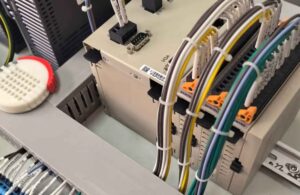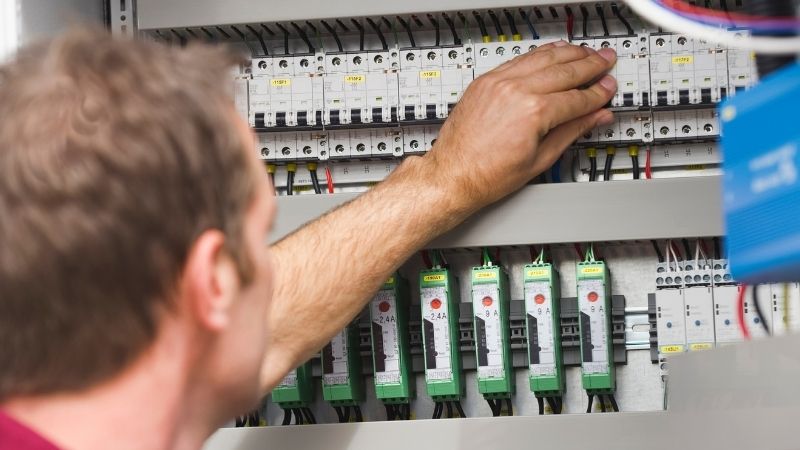Alapvető útmutató a PLC hibákhoz és hibaelhárítási technikákhoz
Ebben az útmutatóban a gyakori okokat ismertetjük PLC meghibásodások, figyelmeztető jelek azonosítása és hibaelhárítási technikák felvázolása, amelyek segítenek a problémák azonnali megoldásában és az állásidő minimalizálásában.
Tartalomjegyzék
A PLC-hibák gyakori okai
A PLC-k számos okból meghibásodhatnak, a környezeti tényezőktől a kezelői hibákig. Ezen okok megértése kulcsfontosságú a meghibásodások megelőzésében.
- Elektromos hibák: Túlfeszültség-ingadozások, feszültségingadozások vagy elektromos hibák károsíthatják a PLC alkatrészeit, ami meghibásodáshoz vezethet. Alapvető fontosságú a megelőző karbantartás, beleértve a túlfeszültség elleni védelmet és az áramellátás következetes felügyeletét.
- Környezeti stressz: A magas hőmérsékletnek, pornak, nedvességnek és korrozív vegyszereknek való kitettség idővel ronthatja a PLC teljesítményét. A rendszeres tisztítás és a megfelelő védelem csökkentheti ezeket a kockázatokat.
- Szoftverproblémák: Szoftverhibák, például programozási hibák vagy inkompatibilitások leállíthatják a PLC működését. A szoftverek naprakészen tartása és a legjobb programozási gyakorlatok betartása megelőzheti ezeket a hibákat.
- Alkatrész romlása: Mint minden mechanikus rendszernél, a PLC alkatrészei, például a ventilátorok és a csatlakozók, használat közben elhasználódhatnak. Az időszakos ellenőrzések és az időben történő cserék segítenek megelőzni a hibákat.
- Elektromágneses interferencia (EMI): A közeli berendezésektől származó interferencia megzavarhatja a PLC működését. Az árnyékolás és a megfelelő földelés minimálisra csökkenti ezeket a problémákat.
- Emberi hiba: A véletlen adatbeviteli hibák vagy a nem megfelelő kezelés hibás működést okozhat. A megfelelő képzés és az ellenőrzött hozzáférés csökkenti ezeknek a hibáknak a valószínűségét.
A PLC hibás működésének fő jelzői
A PLC-problémák korai jeleinek észlelése lehetővé teszi, hogy kezelje azokat, még mielőtt eszkalálódnak.
- Hibátlan be- és kimenetek: Az instabil bemeneti és kimeneti jelek a PLC rendszer lehetséges problémáinak jelei.
- Erő instabilitás: A hibás tápegység gyakran rendszerleállást vagy időszakos meghibásodást okoz.
- Elektromos zaj: A külső forrásokból származó elektromos interferencia megzavarhatja a leolvasást, és váratlan viselkedéshez vezethet a PLC-ben.
- Kommunikációs hibák: Ha a PLC megszakítja a hálózati kapcsolatot, vagy gyakori kommunikációs hibákat mutat, az belső hibát jelezhet.
- Túlmelegedés: A rendszeren belüli túlzott hőség belső alkatrészproblémákat jelezhet, amelyek potenciálisan károsíthatják az érzékeny részeket.
- Memória korrupció: A sérült memória a PLC-ben rendszerösszeomláshoz és megbízhatatlan teljesítményhez vezethet.
A PLC alapvető hibaelhárítási lépései
A szisztematikus megközelítés számos PLC-problémát hatékonyan megoldhat.
- Ellenőrizze a tápegységet: Győződjön meg arról, hogy a PLC tápegysége stabil és megfelelően működik. A feszültségszintek tesztelése és a tápcsatlakozások ellenőrzése jó kiindulópont.
- Ellenőrizze a föld integritását: A nem megfelelő földelés elektromos zajhoz vezethet. A megfelelő földelés kiküszöböli az interferenciát, javítva a PLC teljesítményét.
- Vizsgálja meg a bemeneti és kimeneti eszközöket: Hibás érzékelők, működtetők vagy hibás bekötések rendszerhibákat okozhatnak. A bemeneti/kimeneti kapcsolatok ellenőrzése segít a hibás alkatrészek elkülönítésében.
- Vizsgálja meg az állapotjelzőket: A PLC-k gyakran rendelkeznek LED-ekkel vagy diagnosztikai jelzőfényekkel. Ezen mutatók áttekintése és a PLC kézikönyvének tanulmányozása konkrét hibakódokat vagy figyelmeztetéseket tárhat fel.
Speciális hibaelhárítási technikák
A speciális módszerek összetett problémák vagy ismétlődő PLC-hibák esetén hasznosak.
- A rendszer viselkedésének figyelése: A trend- és eseménynaplók használata segít a PLC-teljesítmény mintáinak azonosításában. A hőmérséklet-változások, a feszültségingadozások és a riasztási előzmények nyomon követése feltárhatja a mögöttes problémákat.
- Végezzen rendszerellenőrzést: A PLC-kábelezés, a komponenscsatlakozások és a programozási konfigurációk rendszeres ellenőrzése segít felismerni a lehetséges hibákat, mielőtt azok befolyásolnák a működést.
- PID hangolás: A PID (arányos integrált származékos) vezérlők hangolása biztosítja a rendszerváltozók pontos szabályozását. A megfelelő hangolás kulcsfontosságú az összetett szabályozási hurkok stabilitásához.
- A program hibakeresése: A speciális hibaelhárítás magában foglalhatja a PLC kódjának átlépését a szoftverhibák vagy logikai problémák azonosítása érdekében. Számos PLC márka kínál hibakereső eszközöket a szoftverében.
PLC-rendszerek megelőző karbantartása
A rendszeres karbantartás elengedhetetlen a PLC-rendszerek élettartamának és teljesítményének meghosszabbításához.
- Környezetvédelem: A PLC stabil, tiszta környezetben való tartása megakadályozza a por, nedvesség és hőmérséklet-ingadozás okozta károsodást.
- Alkatrész csere: Az elöregedett alkatrészek, például ventilátorok és csatlakozók rendszeres cseréje csökkenti a kopással kapcsolatos meghibásodások kockázatát.
- Szoftverfrissítések: A következetes szoftverfrissítések javítják a funkcionalitást és a biztonságot, biztosítva a kompatibilitást más ipari összetevőkkel.
Erőforrások és támogatás kihasználása
Használja fel a rendelkezésre álló erőforrásokat a hibaelhárítás és a javítások segítésére.
- Eladói dokumentáció: A kézikönyvek és a műszaki specifikációk értékes referenciák a PLC-problémák diagnosztizálása és hibaelhárítása során.
- Online fórumok és oktatóanyagok: Az online források, beleértve a fórumokat és az oktatóvideókat, gyakorlati tippeket és közösségi támogatást nyújtanak más szakemberektől.
- Szakértők tanácsadása: Összetett problémák esetén, ha egy tapasztalt PLC-technikushoz vagy támogatási csapathoz fordul, felgyorsíthatja a hibaelhárítást és biztosíthatja a javítások hatékonyságát.
Erősítse meg projektjeit vadonatúj, eredeti Omron, Mitsubishi, Schneider PLC segítségével – raktáron, készen áll!
Következtetés
A PLC-rendszer karbantartása elengedhetetlen a zavartalan ipari működéshez. A gyakori hibák megértésével, a korai figyelmeztető jelek azonosításával és a szisztematikus hibaelhárítási lépések követésével minimalizálhatja az állásidőt és megőrizheti a rendszer megbízhatóságát.
Szerelje be a megelőző karbantartást, és tájékozódjon a legjobb hibaelhárítási gyakorlatokról az automatizálási folyamatok zökkenőmentes működése érdekében.
Új, eredeti PLC-ket keres projektjeihez? A Kwoco-nál a legfrissebb PLC-ket kínáljuk olyan legnépszerűbb márkáktól, mint például Omron, Mitsubishi, és Schneider. Vásároljon bizalommal – gyors szállítás, garantált minőség! Vásároljon most
Lépjen kapcsolatba velünk
Csak töltse ki nevét, e-mail címét és kérésének rövid leírását ezen az űrlapon. 24 órán belül felvesszük Önnel a kapcsolatot.
Ezeket a témákat is érdekesnek találhatja

A fotoelektromos érzékelők és alkalmazásaik ismerete
A fotoelektromos érzékelők mindenütt jelen vannak a modern ipari automatizálásban, és számos rendszer „szemeként” működnek. Létfontosságú, érintésmentes tárgyak észlelését biztosítják, az egyszerű szállítószalag-rendszerektől a bonyolult robot-összeszerelő sorokig mindenre hatással vannak. Ez a cikk mélyen belemerül a fotoelektromos érzékelők világába, feltárja különböző típusaikat, működési elveiket és változatos alkalmazásaikat. Ha gépgyártással, gyári megoldásokkal vagy általános ipari automatizálással foglalkozik, ezeknek az érzékelőknek a megértése elengedhetetlen a folyamatok optimalizálásához és a hatékony, megbízható működés biztosításához. Ez az olvasás megadja ezt a megértést.

PLC program átvitele új PLC-re
Ahogy az Ipar 4.0 és az intelligens gyártási kezdeményezések mozgatják a világot, számos vállalat alapvető automatizálási eszközei – a programozható logikai vezérlőik (PLC-k) – elavulással és teljesítménybeli szűk keresztmetszetekkel szembesülnek.

A végálláskapcsolók magyarázata: típusok, felhasználások és működési elvek
A végálláskapcsolók számos eszköz és gép kritikus alkatrészei, kulcsszerepet játszanak egy tárgy jelenlétének vagy hiányának észlelésében. Legyen szó hűtőszekrényajtóról vagy ipari gépről, a végálláskapcsolók a kulisszák mögötti hősök, olyan funkciókat látnak el, amelyek biztosítják a zavartalan működést és a biztonságot.






